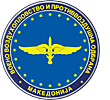The development of the North Macedonian Air Force and Air Defence Forces started from scratch in 1992, because the former Yugoslav Army took all the weapons and equipment which Macedonia had accumulated, wiping out a 45-year investment. More than 35 aircraft (among them the J-22/IJ-22 Orao, J-21/IJ-21 Jastreb, UTVA-66 and SA.341H Gazelle-HERA) located at Petrovec Air Force Base, near Skopje were distributed to airbases all over the Federal Republic of Yugoslavia.
The North Macedonian Air Force and Air Defence Forces (Makedonsko Voeno Vozduhoplovstvo i Protivvozdushna Odbrana) was created on June 10, 1992. The UTVA-66 and UTVA-75 were the first types to be introduced into the North Macedonian Air Force and Air Defence Forces. Upon its creation, the North Macedonian Air Force and Air Defence Forces could count on one UTVA-66 and four UTVA-75 two-seat trainers, all leased from the Makedonski Vozduhoploven Sojuz (Macedonian Aeronautical Union). The official name of the North Macedonian Air Force and Air Defence Forces is: Voeno Vozduhoplovstvo i Protivvozdushna Odbrana na Armijata na Republika Makedonija, which translates as Air Force and Air Defence Forces of the Army of the Republic of North Macedonia. It is commonly abbreviated as VV i PVO ARM.
After the full-scale conflict began in 1991 in the newly independent republics of Croatia and Bosnia-Herzegovina, the Security Council unanimously adopted resolution, requesting the immediate UN arms embargo to Bosnia-Herzegovina, Croatia, Federal Republic of Yugoslavia, North Macedonia and Slovenia. This resolution was seen by North Macedonia as unfair, because North Macedonia was the only one of the former Yugoslav Republics that has gained its independence as a state by peaceful means. In 1994, the North Macedonian Air Force and Air Defence Forces acquired four Mi-17 Hip helicopters from the Ukraine. Because of the arms embargo they were delivered to the North Macedonian Air Force and Air Defence Forces with civil registrations. In 1996, the Security Council excluded North Macedonia from the UN arms embargo. Short after this all four Mi-17s of the North Macedonian Air Force and Air Defence Forces were painted in camouflage schemes and they received military serials.
Four Zlin 242L two-seat trainers were acquired from the Czech Republic in 1995. They are suitable for basic, aerobatic, navigation, instrument and night flying, for formation flying and combat maneuvers. One Zlin 242L was lost on April 7, 1999 when it crashed about 1 km west of Mantovo Accumulation Lake, near Radovish, the pilot escaping with minor injuries.
During the Kosovo crisis, the North Macedonian Air Force and Air Defence Forces dislocated all its aircraft on safe places, deeply in North Macedonian territory, from where it was actively involved in monitoring the trouble borders with Yugoslavia (in the part with Kosovo) and Albania as well in supplying a number of refugee camps with Albanians from Kosovo with food, water and medical care.
After the withdrawal of Yugoslav security forces from Kosovo and entering of NATO in Kosovo, UN decide to disarm the so-called Kosovo Liberation Army (KLA). Since spring 2000, Albanian terrorists have launched a large scale of frontal assaults on police stations, check-points and border-points in southern Serbia and North Macedonia. The crisis between Albanian terrorists and the North Macedonian Government forces broke out in March 2001. During the fightings the North Macedonian Air Force and Air Defence Forces has rapidly expanded itself receiving additional 20 aircraft. The first big-quantity delivery of new aircraft to the North Macedonian Air Force and Air Defence Forces was made on March 23. That day, Ukraine donated to Macedonia four Mi-8MT combat helicopters, that served with Ukrainian contingent of KFOR on Kosovo, and as a part of old agreement delivered additional two Mi-24V Hind-E combat helicopters. Solidarity of Greece with the North Macedonian Government was also shown that day with the delivery of two UH-1H Huey helicopters to the North Macedonian Air Force and Air Defence Forces. On April 15 two more, and on June 15 four more and on September 4 two more Mi-24's followed from the Ukraine. In June 2001 four Su-25 (three Su-25 and one Su-25UB) arrived, marking them the first combat fighters for the North Macedonian Air Force and Air Defence Forces. In December 2001 the North Macedonian Air Force and Air Defence Forces received two Mi-24K Hind-G2 (photo-reconnaissance and artillery spotting version of Mi-24) helicopters from Ukraine.
As a response on brutal assaults of Albanian terrorists on the town of Tetovo, in the dawn of March 25, North Macedonian security forces launch a full scale offensive in order to neutralize and eliminate them. In this operation, North Macedonian Security forces used Mi-17 transport helicopters and recently acquired Mi-8MT combat helicopters. This was the first time that North Macedonian Air Force and Air Defence Forces aircraft was involved in combat. On June 24, one Su-25 took off from Petrovec Air Force base and was involved in observing the scene over Arachinovo village where heavy fighting were underway. This was the first time in the history that a fixed wing Macedonian Air Force and Air Defence Forces combat aircraft had operated from a North Macedonian Air Force and Air Defence Forces base. The only lose of equipment that North Macedonian Air Force and Air Defence Forces has during the fightings was the crash of the Mi-17 helicopter on March 17.
During the fightings, as in any other war, a number of rumours have surfaced about possible acquisitions by the North Macedonian Air Force and Air Defence Forces. This includes the reports that North Macedonia was attempting to acquire six J-21 Jastreb ground attack aircraft from Yugoslavia and ten Britten-Norman BN2T-4S Defender 4000 multi-sensor surveillance from unnamed country. In few occasions there were also reports that North Macedonian Air Force and Air Defence Forces for some time was operating two Kamov Ka-50 close-support helicopters that were acquired from Russia. The North Macedonian Ministry of Defence demanded all this information. Another disinformation comes during June, when North Macedonian media reported that the country is negotiating with Ukraine to buy six MiG-29 Fulcrum fighters. This was followed in early August by Greek medias reports that Turkey is offering North Macedonia leasing of two squadron with 24 F-16C/D Fighting Falcon fighters. The last rumours come on August 2, when Sunday Times reported that North Macedonia will purchase Su-25KM Scorpion, a new "retrofit" version of the Frogfoot, complete with Israeli avionics fitted in the former Soviet republic of Georgia.
As a part of succession of property and equipment of the former Yugoslav Peoples Army, on October 18, Yugoslavia offers North Macedonia a long list of weapons and equipment that this country is ready to deliver to the North Macedonian Army. According to the initial reports of the North Macedonian media, the country among others will receive four SOKO G-4 Super Galeb jets, one An-26 transport aircraft, one Yak-40 transport aircraft, cabinets for pilots education for the North Macedonian Military Academy "General Mihailo Apostolski" and surface-to-air missile systems. Until today there was no update regarding the possibility for delivering Yugoslav weapons and equipment to North Macedonia which put the realization of this project under big mark of question.
During December 2001, the new organization structure of the North Macedonian Air Force and Air Defence Forces was put on strength. Until then, North Macedonian Air Force and Air Defence Forces Airborne Brigade (Avio Brigada) was organized in three squadrons: 101. Avijaciska Eskadrila (or 101. AE, 101 Aviation Squadron), 201. Protiv Oklopna Helikopterska Eskadrila (or 201. POHE, 201 Anti Armour Helicopter Squadron) and 301. Transportna Helikopterska Eskadrila (or 301. TRHE, 301 Transport Helicopter Squadron). With the latest changes in the organization of the North Macedonian Air Force and Air Defence Forces, Avio Brigada (Airborne Brigade) became Avio Bataljon (Airborne Battalion) and Eskadrila (Squadron) became Cheta (Company). So, 101. AE became 101. Avijaciska Cheta (or 101. ACh, 101 Aviation Company), 201. POHE became 201. Protiv Oklopna Helikopterska Cheta (or 201. POHCh, 201 Anti Armour Helicopter Company) and 301. TRHE became 301. Transportna Helikopterska Cheta (or 301. TRHCh, 301 Transport Helicopter Company). As part of the big reorganization of the Macedonian Air Force and Air Defence Forces new company was also established. Named as 401. Shkolsko Trenazna Cheta (or 401. ShTCh, 401 Training Company), this company now operates four Zlin 242Ls, a single Zlin 143L and two UH-1Hs. Before coming part of the 401. ShTCh, the four original Zlin 242L two-seat trainers were part of the 101. AE and UH-1H helicopters were part of the 301. TRHE. In 2003 a four-seat Zlin 143L and one more two-seat Zlin 242L were acquired from the North Macedonian Authority for Civil Aeronautical Transport and Traffic. Training on the new Zlins started early 2004 and the original three Zlin 242s went to Moravan Aeroplanes in Czech for overhaul.
The North Macedonian Air Force and Air Defence Forces elite 501 parachute diversion detachment (501. Padobransko Diverzantski Odred) called "Falcons" (Sokoli) was officially promoted during the big military exercise that took place at Cojlija military range, near Petrovec Air Force base, on May 28, 2002. The exercise activities of this unit encompassed technical presentation of the equipment and the weaponry, search and rescue (SAR) operations, combat search and rescue (CSAR) of the pilot on hostile territory with the tactic operation called "small diamond." The "Falkons" also demonstrated leading North Macedonian Air Force and Air Defence Forces aircraft towards enemy positions (FOC - Forward Air Controllers), opening rifle fire from Mi-8MT and Mi-24V helicopters, parachute jumps and High-Altitude Low-Opening (HALO) parachute jumps. In peacetime the 501. PDO is under the command of the North Macedonian Air Force and Air Defence Forces and its main task is search, rescue and medical evacuation of the flying staff. In case of natural disasters its aim is assisting the population. Members of the 501. PDO are all experienced professional soldiers who had participated in the missions of NATO and Partnership for Peace program. According to Major Goran Grujovski, the 501. PDO aim is to become the most elite unit of the North Macedonian Army.
North Macedonia is one of nine Central and Eastern European countries that are actively seeking membership in NATO. In wish to meet all obligations for full integration and membership in NATO, North Macedonia already equipped its Air Force and Air Defence Forces fighters and helicopters with NATO compatible communication systems. For better protection of its borders with south Serbian province of Kosovo and with Albania, especially at night, North Macedonia equiped Hip and Hind helicopters with FLIR equipment. Priority in acquisitions for the North Macedonian Air Force and Air Defence Forces in the future will be equipping utility helicopters. The four Su-25 Frogfoots were withdrawn from use during 2004 according to the draft to join NATO.
When there is a need, for example in warfare situation, North Macedonian Air Force and Air Defence Forces can use all the Macedonian Aeronautical Union aircraft, among them five survived UTVA-75 two-seat trainers and 16 An-2 Colt transport aircraft.



